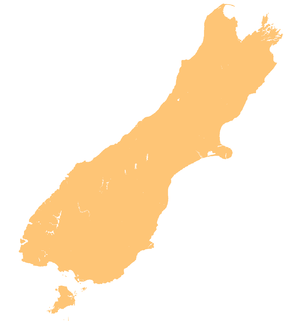| Kahurangi Marine Reserve | |
|---|---|
 | |
| Location | Buller District, New Zealand |
| Nearest city | Nelson |
| Coordinates | 40°57′29″S 172°06′04″E / 40.957941°S 172.1010063°E |
| Area | 8,419 hectares (20,800 acres) |
| Established | 2014 |
| Governing body | Department of Conservation |
Kahurangi Marine Reserve is a marine reserve administered by the Department of Conservation, covering 8,419 hectares (20,800 acres) offshore of Kahurangi National Park in the Buller District of New Zealand's West Coast Region.[1][2]
Geography
[edit]Kahurangi is one of the largest marine reserves in New Zealand, extending along 16 kilometres (9.9 mi) of coastline between Wekakura Point and Crayfish Point, and 5 kilometres (3.1 mi) out to sea.[3]
The reserve features an area of remote coastline with sandy beaches and boulders, alongside nīkau forest. The northern end of the coast is a habitat for fur seals (Kekeno) and Hector's dolphins, and driftwood along the coast is a habitat for animals like earwigs, sandhoppers and spiders. Rocky reefs and seastacks provide a habitat for encrusting animals, invertebrates and inshore fish that thrive in murky waters.[1]
The reserve reaches depths of about 50 metres (160 ft), with a seabed of mud and sand providing a habitat for burrowing shellfish and coastal fish like flounder, gurnard, snapper and sharks.[1]
History
[edit]The reserve was proposed in September 2011,[4] and was formally approved by Conservation Minister Nick Smith in March 2013.[5] It was much smaller than what had originally been proposed.[6]
The regulation establishing the marine reserve was passed by Prime Minister John Key on 11 August 2014, and took effect 7 September 2014.[7]
In October 2016, rangers using a helicopter spotted the crew of a fishing vessel trawling within the reserve.[8]
In December 2017, another fisher was fined $16,000 for fishing in the reserve.[9]
In December 2020, a man from Nelson was fined $13,500 for commercial fishing in the marine reserve.[10] According to a court summary of facts, he deployed a bottom trawl net the previous New Year's Eve while travelling back from a fishing trip at Greymouth.[11] He did not know the area was a marine reserve.[12]
Recreation
[edit]Visitors are urged to travel with sufficient food, water, warm clothing and wet weather gear, and tell people where they are going and when they expect to return. They must remain at least 20 metres (66 ft) from seals at all times.[1]
Quad bikes and horses can be ridden within the reserve, provided disturbance is minimal. Small stones, shells, driftwood, sand and gravel can be collected in small quantities by hand. Pounamu can also be collected by Ngāi Tahu or with iwi permission.[1]
See also
[edit]References
[edit]- ^ a b c d e "Kahurangi Marine Reserve". Department of Conservation.
- ^ Hutching, Gerard. "Marine protected areas". Te Ara - the Encyclopedia of New Zealand. Ministry for Culture and Heritage.
- ^ "Kahurangi Marine Reserve". aa.co.nz. Automobile Association of New Zealand.
- ^ "Five marine reserves announced for NZ". Mercator Media. World Fishing and Aquaculture. 8 September 2011.
- ^ "Five marine reserves for West Coast". stuff.co.nz. 10 March 2013.
- ^ Mills, Laura (20 September 2014). "Small West Coast marine reserves an 'insult'". New Zealand Media and Entertainment. Greymouth Star.
- ^ "Marine Reserve (Kahurangi) Order 2014". legislation.govt.nz.
- ^ Mills, Laura (12 October 2016). "First serious breach in West Coast marine reserve". New Zealand Media and Entertainment. Greymouth Star.
- ^ "Commercial fisherman fined $16k for marine reserve abuse". Association of Resource Management Practitioners. 14 December 2017.
- ^ "Nelson fisher fined $13,500 for fishing in a protected marine reserve". New Zealand Government. Ministry for Primary Industries. 9 December 2020.
- ^ Gee, Samantha (9 December 202). "Commercial fisherman fined $13.5k for fishing in Kahurangi Marine Reserve". stuff.co.nz.
- ^ Fyfe, James (9 December 2020). "Nelson fisherman fined $13,500 for fishing in marine reserve". MediaWorks New Zealand. Newshub.[dead link]
